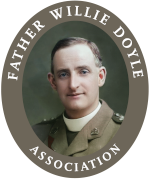During the winter I have done a penance which I shrink from and dread in a way which I cannot describe. I have had to drive myself by vow to perform it. I set my alarm for three o’clock when it is freezing, slip out of the house in my night-shirt and stand up to my neck in the pond, praying for sinners.
COMMENT: Fr Doyle lived a life of hard penance. While penance and self-denial are essential for spiritual growth, it is clear that most of us are not called to copy this aspect of his life. Fr Doyle clearly felt that he had a very specific call to live this hard life. His confessor seems to have also agreed with this, and to have suggested various modifications to his penances which he gladly implemented.
Fr Doyle’s penances are controversial for some people. It is worth noting that most of the most popular and beloved saints also practiced lives of great austerity. In fact, St Ignatius himself practiced this very same penance of praying whilst standing in a cold lake. These penances have not reduced the popularity of either Ignatius or of the other saints who did similar mortifications. It is also worth bearing in mind that physical mortification was very much the norm during Fr Doyle’s time, and that whatever Fr Doyle did has to be seen in that context.
Later in Lent we will return to a more detailed analysis of Fr Doyle’s penitential practices.
The example of Fr Doyle’s penance in the lake came to mind when reading an account of the Forth Martyrs of Sebaste in Armenia, whose feast it is today. Here is a description of their martyrdom from Butler’s Lives of the Saints, itself an important source of inspiration for Fr Doyle as a young man:
The forty martyrs were soldiers quartered at Sebaste in Armenia, about the year 320. When their legion was ordered to offer sacrifice they separated themselves from the rest and formed a company of martyrs. After they had been torn by scourges and iron hooks they were chained together and led to a lingering death.
It was a cruel winter, and they were condemned to lie naked on the icy surface of a pond in the open air till they were frozen to death. But they ran undismayed to the place of their combat, joyfully stripped off their garments, and with one voice besought God to keep their ranks unbroken. “Forty,” they cried, “we have come to combat: grant that forty may be crowned.” There were warm baths hard by, ready for any one amongst them who would deny Christ.
The soldiers who watched saw angels descending with thirty-nine crowns, and, while he wondered at the deficiency in the number, one of the confessors lost heart, renounced his faith, and, crawling to the fire, died body and soul at the spot where he expected relief. But the soldier was inspired to confess Christ and take his place, and again the number of forty was complete.
They remained steadfast while their limbs grew stiff and frozen, and died one by one. Among the Forty there was a young soldier who held nut longest against the cold, and when the officers came to cart away the dead bodies they found him still breathing. They were moved with pity, and wanted to leave him alive in the hope that he would still change his mind. But his mother stood by, and ‘this valiant woman could not bear to see her son separated from the band of martyrs. She exhorted him to persevere, and lifted his frozen body into the cart. He was just able to make a sign of recognition, and was borne away, to be thrown into the flames with the dead bodies of his brethren.
It is perhaps significant that these 40 martyrs were soldiers. Undoubtedly they received many graces to help them withstand these austerities for so long. But it is also likely that their physical training as soldiers toughened them up as well.
So too, then, with Fr Doyle. If we admire the hero of the trenches with his radiant cheerfulness and disregard of his own comfort in the service of others, we must also respect the spiritual and physical training he undertook in his earlier life. His penances were – unknown to him at the time – the training ground for the heroism of the war years. It seems impossible that we can have one without the other.
And this brings us back to ourselves, and our Lenten observance. If we wish to grow and overcome our weaknesses and vices, then we must train ourselves, and we do this by means of our Lenten resolutions and self-denial. There can be a temptation to consider this idea of spiritual growth as quaint or irrelevant. But who amongst us doesn’t need to improve? Don’t we want to be better parents and spouses? Wouldn’t our families or religious communities be more peaceful places if we all worked to perfect ourselves and overcome our faults? Wouldn’t our world be a better place if individuals had more self-control and patience and dedication to duty? Perhaps this idea of growing in virtue is not so out of date after all…

